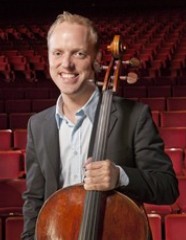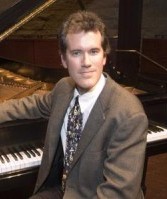
Cincinnati Chamber Orchestra's "American Romantics" An Adventure

“American Romantics,” the Cincinnati Chamber Orchestra’s
inspired program Sunday afternoon in Mayerson Theater at the School for Creative and Performing
Arts, delivered more than its title likely implied.

With composers like Aaron Copland and Samuel Barber on the program, one might have expected well-traveled classics like “Appalachian Spring” or Adagio for Strings.
CCO music director Mischa Santora had a broader sweep in mind, with lesser known works like Copland’s “Music for the Theatre” and Barber’s Cello Concerto in A Minor. Add jazz greats like Fats Waller and Thelonius Monk, and it made for an engrossing immersion in American music from the first half of the 20th century. The not-so-wild card was Czech composer Antonin Dvorak, whose visit to the United States during the 1890s yielded a crop of American-inspired music (“New World” Symphony, “American String Quartet,” etc.), but again, Santora went for a lesser known example, his “American” Suite, Op. 98b (1894).
The excellent soloists were cellist Joseph Johnson and pianist Michael Chertock.
Jazz was the rage with French composers during the 1920s, and when Copland returned from his studies in Paris, he embraced the art form in his own music. “Music for the Theatre” (1925) is an example. Commissioned and premiered by Serge Koussevitsky and the Boston Symphony, it is in five short movements, Prologue, Dance, Interlude, Burlesque and Epilogue. The title is non-specific and does not refer to actual theater music. Santora and the CCO made great fun of it. The Prologue opened with trumpet and drums, fanfare-style, and you could hear Copland’s spacious, “prairie” sound (familiar from his music of the 30s and 40s), as well as exuberant jazz in the balance of the movement. Clarinet and trumpet faced off in the Dance (CCO principal clarinet John Kurokawa and principal trumpet Ashley Hall), and the Interlude was bluesy, with a soulful English horn solo (Emily Van Niman). Galomping basses introduced sassy woodwinds in the Burlesque, and the Epilogue reprised and further developed the reflective mood of the Prologue (compliments to CCO violist Heidi Yenney and concertmaster Amy Kiradjieff).
Chertock, pianist in the Copland, moved to the Steinway at the front of the stage for the jazz set, which he prefaced with an enlightening exposition of jazz itself. What jazz shares with so-called “classical” music, said Chertock, is the importance of improvisation and the centrality of the piano. They also share a similar trajectory, with jazz deriving from spirituals and the blues the way classical music grew out of Gregorian chant and troubadour songs, he said.
Chertock followed with a classy performance of variations on Waller’s “Ain’t Misbehavin’” (arranged by Jelly Roll Morton, Art Tatum and Judy Carmichael), which he alternated with Monk’s “Around Midnight” and Jimmy Rowles’ “502 Blues.” (Santora looked on admiringly from his seat on the podium.)
Chicago native Johnson, currently principal cellist of the Toronto Symphony, no doubt provided a first exposure to Barber’s Cello Concerto for most people in the audience. Though a substantial and highly rewarding work, it is not often performed because of its extreme technical demands. Much of it lies in the cello’s highest register, and there are numerous, rapid excursions up and down the strings, complex double-stopping, and the like. However, with enough champions like Johnson, it could easily re-enter the repertoire. Johnson and the CCO presented it well, indeed. The Allegro moderato, which features a catchy, convoluted theme, bristled along to the cello’s rapid ascent up the A string to a stratospheric high note (nailed somewhat breathlessly by Johnson). The Andante opened with a lovely dialogue between Johnson and CCO oboist Lorraine Dorsey. Johnson was a skillful colorist across the cello’s wide range, ending with a solo on the lowest string, where his sound blended warmly with the deep hues of the CCO cellos and basses. The finale, Molto allegro e passionato, was highly dramatic. Johnson spent most of his time on the A string – there was an almost comical exchange between cello and clarinet at one point – and he blazed through a brief lick of cadenza to a pell mell, cataclysmic finish.
Santora opened the second half with a welcome performance of Dvorak’s “American” Suite (originally for piano and later orchestrated by the composer). The word should be taken as a kind of “made in America” label, since the music seems as much (or more) European than American. The second movement, a Moderato rondo, is even designated “alla polacca” (“in the manner of a polonaise). Overall, it has a simple, charming aspect, with a folk-like Allegro, graceful Moderato, wistful Andante and dancelike Allegro finale, complete with triangle.
The CCO concludes its 2011-2012 “American Perspectives” season June 3 in SCPA’s Corbett Theater with “American Narratives,” including music by Michael Daugherty (his Violin Concerto “Fire and Blood”) and Duke Ellington. Information at www.ccocincinnati.org